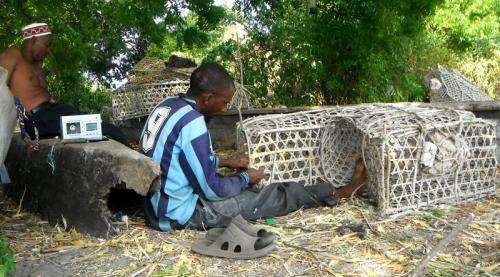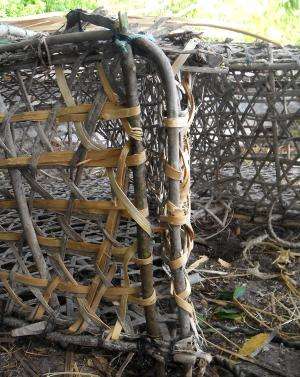Building a better fish trap: WCS reduces fish bycatch with escape gaps in Africa

Scientists from the Wildlife Conservation Society and the Kenyan Marine and Fisheries Research Institute have achieved a milestone in Africa: they've helped build a better fish trap, one that keeps valuable fish in while letting undersized juvenile fish and non-target species out.
By modifying conventional African basket traps with escape gaps, the marine researchers have proven that the new traps catch larger fish, allow more undersized and non-target fish to escape, increase profits, and—most importantly—minimize the impact of fishing on coastal reef systems. The findings, say researchers, will help fishing communities boost profits while protecting their vital marine resources.
A paper on the experimental study appears in the current edition of Fisheries Research. The authors include E.K. Mbaru of the Coral Reef Conservation Project and the Kenyan Marine and Fisheries Research Institute; and Tim McClanahan of the Wildlife Conservation Society.
"One of the great challenges in coastal fisheries is how to reduce the levels of bycatch for reef systems where these species play important ecological roles," said Dr. Tim McClanahan, co-author of the study and head of WCS's coral reef research and conservation program. "Our modified traps have made a statistically measurable difference in minimizing bycatch for African basket traps. Such innovations can make a big difference in maintaining the ecology of vital coastal resources."
The experimental study was conducted in the fished reef systems near a marine park on the coast of Mombasa, Kenya. Importing the escape gap idea to African waters for the first time, the researchers worked with an experienced trap fisher who built six basket traps—iron-framed structures with netting and a single, tube-shaped opening leading into the middle of the trap. Half of the traps were constructed with escape gaps measuring 12 inches by an inch and a half. The escape gaps were designed to allow undersized and non-target fish to exit while retaining commercially valuable adult fish.

Once baited, the traps were deployed some 30 meters apart and between 5 and 10 meters in depth and checked once a day between October 2010 and October 2011. After 41 weeks, the researchers captured more than 1,200 fish from 64 species. The fish captured in the experimental traps were on average 31 percent longer and 55 percent heavier than fish in the regular traps without gaps (used for control data). By contrast, the regular traps had smaller fish, including the juvenile and ornamental fish important for maintaining reef ecology. The researchers also reported a 25 percent increase in economic value in the fish captured in the escape-gap traps, mostly valuable rabbitfishes.
The escape-gap traps also allowed smaller non-target fish to escape. Of the fish caught in the escape-gap traps, only 34 individual fish belonging to "bycatch" species (or 2 percent) remained in the traps, as opposed to 110 individuals (or 6 percent of the catch) from non-commercial species in the regular traps.
"These new escape gaps are a game changer for Kenya's coastal fisheries," said Dr. Caleb McClennen, Director for WCS's Marine Programs. "By reducing bycatch, the new basket traps increase fish size, economic return, while limiting the bycatch that can harm entire reef systems. These innovations can also be exported to other coastal fisheries for the benefit of entire regions."
The escape gap design for African basket traps—created by McClanahan and his WCS colleague Ayana Elizabeth Johnson—received top prize and $20,000 in support for conservation in the 2012 Solution Search: Turning the Tide for Coastal Fisheries, an award created to bring recognition to innovative community-based conservation projects.
Journal information: Fisheries Research
Provided by Wildlife Conservation Society

















